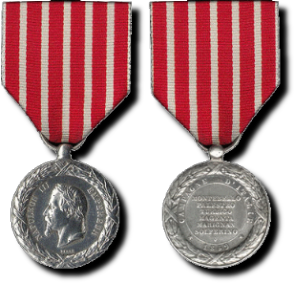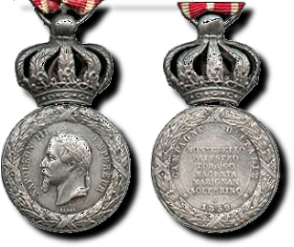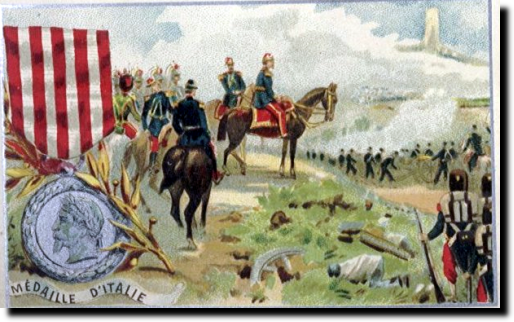150° Anniversario Battaglia di Palestro
Medaglia
Battaglia

Medaglia francese della Campagna d'Italia del 1859




Medaglia francese della Campagna d'Italia del 1859
Questa medaglia fu creata con Delibera Imperiale l'11 agosto 1859 per onorare i soldati e marinai francesi che parteciparono alla guerra francese contro l'Austria, alleati del regno Sardo-Piemontese. E' la medaglia più diffusa del Secondo Impero, un raro esempio, molto bella. La medaglia è in argento circolare con cappio lateralmente forato per la sospensione del nastro.
FRONTE:
ritratto dell'Imperatore Napoleone III con il profilo di sinistra, incoronato con un ghirlanda di alloro e che viene ripetuta sulla circonferenza della medaglia e con la scritta: "NAPOLEON III EMPEREUR" e firmata in basso da Barre (il grande medaglista francese Alberto Désiré Barre, 1818-1878).
RETRO:
scritte con i nomi delle battaglie significative della campagna: "MONTEBELLO, PALESTRO, TURBIGO, MAGENTA, MARIGNAN e SOLFERINO" circondate ad anello dalla scritta "CAMPAGNE D'ITALIE 1859" il tutto fra una corona d'alloro.
Diametro: 30 mm. in argento. Istituita l'11 agosto 1859, per meriti ai membri della spedizione francese ad Italia 1859. Si crede 120'000 medaglie furono coniate. Esiste un modello detto delle "Cento Guardie" nella quale la medaglia è sormontata da una corona imperiale.
NOTE STORICHE:
A partire da 1815, nelle differenti province della penisola italiana, si manifestò un potente movimento popolare che desidera l'unificazione del paese. Questa idea, difesa dal Re di Sardegna Vittorio Emanuele II, era combattuta tuttavia dal Papa PIO IX e dagli Austriaci che occupavano le province di Lombardia e del Veneto. In Europa, questa causa era sostenuta solamente dall'Imperatore Napoleone III che, il 28 gennaio 1859, si impegnava nel trattato di Torino a portare l'aiuto ed il sostegno della Francia. A seguito di una serie di provocazioni, il Piemonte fu invaso, il 26 aprile 1859, da 100'000 soldati austriaci. Questa azione trascinò la Francia a dichiarare guerra all'Impero di Austria, il 3 maggio 1859. Malgrado la cattiva preparazione dell'esercito francese e di quello del Regno Sardo-Piemontese riuscirono comunque a sconfiggere gli Austriaci sostenendo cruente Battaglie come quella di Palestro del 30 e 31 maggio che permise a Napoleone III ed a Vittorio Emanuele II di entrare trionfalmente l'8 giugno a Milano. Il 12 luglio, fu firmato l'armistizio a Villafranca. A Zurigo, il 10 novembre 1859, la Francia firmava un trattato con l'Austria. Il 24 marzo 1860, per il trattato di Torino con i Sardo-Piemontesi, ricevettero la contea di Nizza e la Savoia in cambio dell'annessione degli stati dell'Italia centrale per il Piemonte. Le forze francesi composte di un effettivo di 120'000 uomini, erano sotto il comando diretto dell'Imperatore e collocate sotto gli ordini dei Marescialli Baraguet di HILLIERS e CANROBERT, dei Generali MAC-MAHON, NIEL e Regnault di Sant Jeans D'ANGELY. Durante questi tre mesi di campagna, le perdite francesi si alzarono a 8'000 morti e 40'000 feriti. Per ricompensare tutti i partecipanti a questa gloriosa campagna, la Medaglia della Campagna dell'Italia fu creata da decreto imperiale, l'11 agosto 1859. Circa 120'000 medaglie furono conferite. La medaglia era associata ad un diploma ed era conferita dall'Imperatore Napoleone III, su proposta dei Ministri della Guerra e della Marina.
Médaille de la Campagne d'Italie 1859
Cette médaille fut créée avec Délibération Impériale de 11 août 1859 et il donna à tous les soldats et matelots qu'ils participèrent dans la guerre français contre l'Autriche, alliés du royaume Sarde-piémontais à un pas vers l'unification de l'Italie. Vous médaille fut donnée aux hommes qui composèrent l'armée française en Italie et c'est la médaille la plus diffuse du Second Empire, un exemple rare, très belle. La médaille d'argent circulaire avec noeud coulant latéralement percé pour la suspension de ruban.
AVERS:
je retire de l'empereur Napoléon III avec le profil de gauche, couronné avec une couronne de laurier et qu'elle vient répétée sur le cinconferenza du medeglia et avec l'inscription: "NAPOLEON III EMPEREUR" et griffée en bas de Barre, le grand médailliste français Alberto Désiré Barre, 1818-1878.
REVERS:
écrite avec les noms des batailles significatives de la campagne: "MONTEBELLO, PALESTRO, TURBIGO, MAGENTA, MARIGNAN et SOLFERINO" entourés à la bague de l'inscription "CAMPAGNES D'ITALIE 1859" le tout entre une couronne de laurier.
Diamètre: 30 mm. en argent. Fondée le 11 août 1859, pour mérites aux membres de l'envoi français à Italie 1859. Il se croit 120'000 médailles elles furent frappées. Il a existé un modèle dit des "Cent-Gardes", dont la médaille était surmontée par une couronne impériale.
CONNUES HISTORIENNES:
À partir de 1815, dans les provinces différentes de la péninsule italienne, il se révéla un mouvement populaire puissant qui désire l'unification du pays. Cette idée, défendue par le Roi de la Sardaigne Vittorio Emanuele II, elle était combattue cependant du Pape PIO IX et des Autrichiens qu'ils occupaient les provinces de la Lombardie et de la Vénétie. En Europe, cette cause de l'était soutenue par l'Empereur Napoléon III que, le 28 janvier 1859, il s'engageait dans le traité de Turin à porter l'aide et le soutien de la France. À la suite d'une série de provocations, le Piémont fut envahi, le 26 avril 1859, de 100'000 soldats autrichiens. Cette action traîna la France à déclarer guerre à l'Empire de l'Autriche, le 3 mai 1859. Malgré la mauvaise préparation de l'armée française et ceux du Royaume Sarde-piémontais réussirent à battre les Autrichiens en soutenant sanglantes Batailles comme celle de Palestro le 30 et 31 mai qu'il permit à Napoléon III et Vittorio Emanuele II d'entrer le 8 juin triomphalement à Milan. Le 12 juillet, l'armistice fut signée au Villafranca. À Zurich, le 10 novembre 1859, la France signait un traité avec l'Autriche. Le 24 mars 1860, pour le traité de Turin avec les Sarde-Piémontais, ricevettero le comté de Nice et la Savoie en échange de l'annexion des états de l'Italie centrale pour le Piémont. Les forces françaises compotes d'un effectif de 120'000 hommes étaient sous le commandement direct de l'Empereur et dessous placé les ordres des Maréchaux Baraguet de HILLIERS et CANROBERT, des Généraux MAC-MAHON, NIEL et Regnault de Sant Jeans D'ANGELY. Pendant ces trois mois de campagne, les pertes françaises se levèrent à 8'000 morts et 40'000 blessés. Pour récompenser tous les participants à cette campagne glorieuse, la Médaille de la Campagne de l'Italie elle fut créée par décret impérial le 11 août 1859. 120'000 médailles furent conférées environ. La médaille était remise avec un diplôme et ère conférées par l'Empereur Napoléon III, sur proposition des Ministres de la Guerre et de la Marine.
French medal for the 1859 Italian Campaign
This medal was created by Imperial Resolution on August 11th 1859 and it was awarded to all the soldiers and sailors who had taken part to the French war against Austria in alliance with the kingdom of Sardinia-Piedmont which was fighting for the unification of Italy. The medal was awarded to the men that joined the French army in Italy and it is the most widespread medal in the Second Empire. It is a rare and very beautiful specimen. A suspension is added to the top of the circular silver medal to hold it to a suspension ring, through which a ribbon is run.
OBVERSE:
portrait of the emperor Napoleon III with laureated head, facing left. The garland of laurel leaves is repeated again on the outer edge of the medal and the inscription reads: "NAPOLEON III EMPEREUR". It is signed at the bottom by Barre (the great French medalist Alberto Désiré Barre, 1818-1878).
REVERSE:
engraved with the names of the most significant battles of the campaign: "MONTEBELLO, PALESTRO, TURBIGO, MAGENTA, MARIGNAN and SOLFERINO". The outer edge is engraved with garlands of laurel leaves and with the words "Campagne d'Italie 1859".
Diameter: 30 mms., silver. Created on August 11th 1859 to be awarded to the members of the French expedition to Italy in 1859. It is believed that 120,000 medals were coined. There was also an issue called the "Hundred Guards", whose medal was surmounted by the imperial crown.
HISTORICAL BACKGROUND:
Since 1815, a strong popular movement in favour of the unification of the country spread across the various provinces of the Italian peninsula. The idea was supported by the King of Sardinia, Victor Emmanuel II, while it was opposed by Pope Pius IX and by the Austrians who controlled directly the provinces of Lombardy and Veneto. In Europe, this cause was sustained only by the emperor Napoleon III who committed himself to giving the help and support of France by signing the Treaty of Turin on January 28th 1859. Following a series of provocations, on April 26th 1859 Piedmont was invaded by 100,000 Austrian soldiers. This forced France to declare war to the Austrian Empire, on May 3rd 1859. Despite the bad preparation of their army, the French and the Sardinians succeeded in defeating the Austrians, by sustaining bloody battles such as the battle of Palestro on May 30th and 31st which allowed Napoleon III and Victor Emmanuel II to enter triumphantly into Milan on June 8th. On July 12th, the armistice was signed in Villafranca. On November 10th 1859, in Zurich, France signed a treaty with Austria. On March 24th 1860, in accordance with the Treaty of Turin with the Sardinians, the French were rewarded with the county of Nice and the territories of Savoia while Piedmont annexed the states of central Italy. The French army was composed of 120,000 men, led personally by the Emperor himself and under command of the Marshals Baraguet of HILLIERS and CANROBERT, of the General MAC MAHON, NIEL and Regnault of Sant Jeans D'ANGELY. During the three months of war, the French losses raised up to 8,000 dead and 40,000 wounded. In order to reward all the participants to this glorious campaign, the Medal of the Italian Campaign was issued by imperial decree on August 11th 1859. About 120,000 medals were awarded. The medals were delivered together with a diploma and were bestowed by the Emperor Napoleon III, following to the suggestions of the Minister of War and of the Navy.
